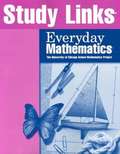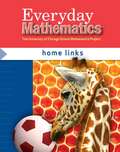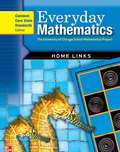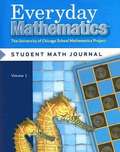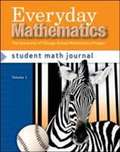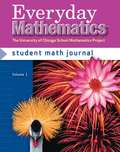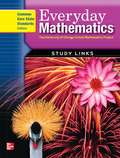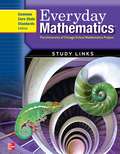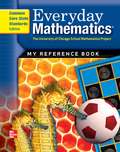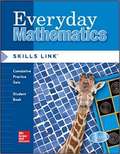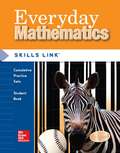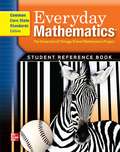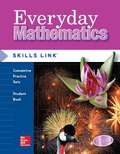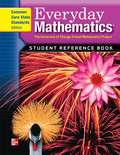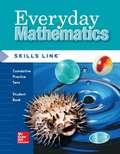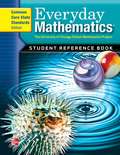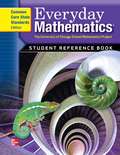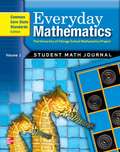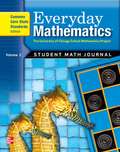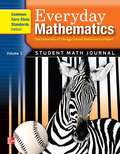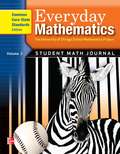- Table View
- List View
Everyday Mathematics: Study Links
by Mcgraw HillEveryday Mathematics offers students a broad background in mathematics. Some approaches in this program may differ from those you used as a student. However, the approaches the authors use are based on research results, field-test experiences, and the mathematics that students will need in the twenty-first century.
Everyday Mathematics: Study Links (Grade #5)
by The University of Chicago School Mathematics ProjectEveryday Mathematics offers students a broad background in Mathematics. It is part of an elementary school mathematics curriculum developed by the University of Chicago School Mathematics Project.
Everyday Mathematics® Grade 1, Home Links
by The University of Chicago School Mathematics Project Max Bell Jean BellNIMAC-sourced textbook
Everyday Mathematics® Grade 2, Home Links
by The University of Chicago School Mathematics Project Max Bell Jean BellNIMAC-sourced textbook
Everyday Mathematics® Grade 2, Student Math Journal Volume 1
by The University of Chicago School Mathematics Project Diana Barrie Max Bell Amy Dillard Y IsaacsNIMAC-sourced textbook
Everyday Mathematics® Grade 3, Student Math Journal Volume 1
by The University of Chicago School Mathematics Project Andy Isaacs Diana Barrie Max Bell Amy DillardNIMAC-sourced textbook
Everyday Mathematics® Grade 4, Student Math Journal Volume 1
by The University of Chicago School Mathematics Project Andy Isaacs Diana Barrie Max Bell Amy DillardNIMAC-sourced textbook
Everyday Mathematics® Grade 4, Study Links
by The University of Chicago School Mathematics Project Max Bell John BretzlaufNIMAC-sourced textbook
Everyday Mathematics® Grade 5, Student Math Journal Volume 1
by The University of Chicago School Mathematics Project Andy Isaacs Diana Barrie Max Bell Amy DillardNIMAC-sourced textbook
Everyday Mathematics® Grade 6, Study Links
by The University of Chicago School Mathematics Project Max Bell John BretzlaufNIMAC-sourced textbook
Everyday Mathematics® [Grade 1-2], My Reference Book
by The University of Chicago School Mathematics Project James Flanders Mary Ellen DairykoNIMAC-sourced textbook
Everyday Mathematics® [Grade 2], Skills Link, Cumulative Practice Sets, Student Book (Everyday Math Skills Links Ser.)
by The University of Chicago School Mathematics ProjectNIMAC-sourced textbook
Everyday Mathematics® [Grade 3], Skills Link, Cumulative Practice Sets, Student Book
by The University of Chicago School Mathematics ProjectNIMAC-sourced textbook
Everyday Mathematics® [Grade 3], Student Reference Book
by The University of Chicago School Mathematics Project Max Bell Jean BellNIMAC-sourced textbook
Everyday Mathematics® [Grade 4], Skills Link, Cumulative Practice Sets, Student Book
by The University of Chicago School Mathematics ProjectNIMAC-sourced textbook
Everyday Mathematics® [Grade 4], Student Reference Book
by The University of Chicago School Mathematics Project Max Bell Jean BellNIMAC-sourced textbook
Everyday Mathematics® [Grade 5], Skills Link, Cumulative Practice Sets, Student Book
by The University of Chicago School Mathematics ProjectNIMAC-sourced textbook
Everyday Mathematics® [Grade 5], Student Reference Book
by The University of Chicago School Mathematics Project Max Bell Jean BellNIMAC-sourced textbook
Everyday Mathematics® [Grade 6], Skills Link, Cumulative Practice Sets, Student Book
by The University of Chicago School Mathematics ProjectNIMAC-sourced textbook
Everyday Mathematics® [Grade 6], Student Reference Book
by The University of Chicago School Mathematics Project Max Bell Jean BellNIMAC-sourced textbook
Everyday Mathematics®, Grade 2, Student Math Journal, Volume 1
by The University of Chicago School Mathematics Project Andy Isaacs Max BellNIMAC-sourced textbook
Everyday Mathematics®, Grade 2, Student Math Journal, Volume 2
by The University of Chicago School Mathematics Project Andy Isaacs Max BellNIMAC-sourced textbook
Everyday Mathematics®, Grade 3, Student Math Journal, Volume 1
by The University of Chicago School Mathematics Project Max Bell Jean BellNIMAC-sourced textbook
